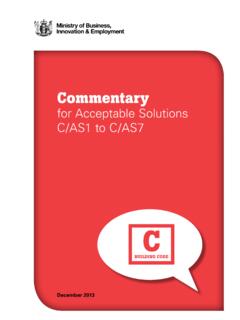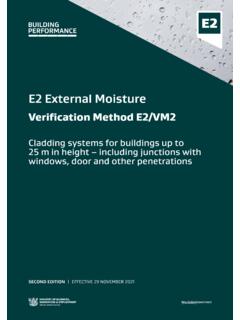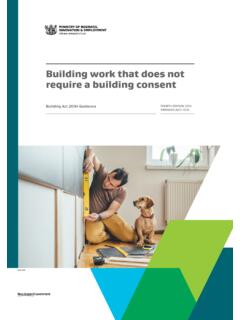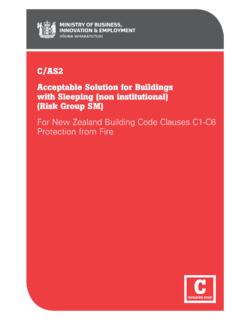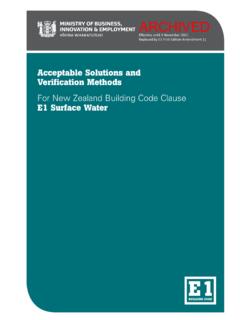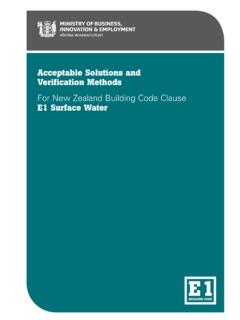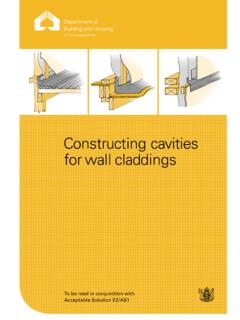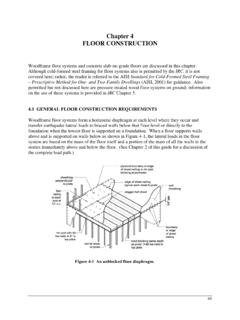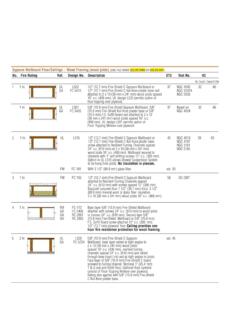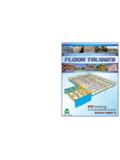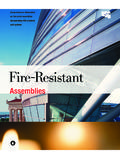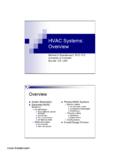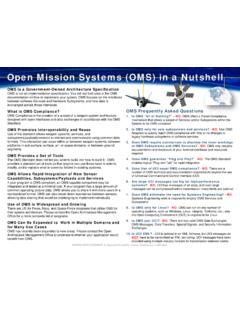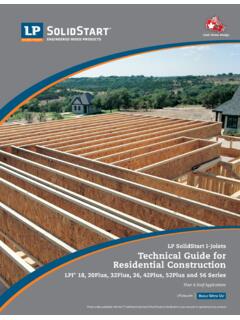Transcription of E3/AS2 Acceptable Solution - Building Performance
1 Internal Wet-area Membrane Building work involving internal wet-area membrane systems that are installed in accordance with sections 1 4 of the Waterproofing Membrane Association Incorporated (WMAI) Code of Practice for Internal Wet Area Membrane Systems (IWAM) as modified by Paragraph of this Acceptable Solution will comply with New Zealand Building Code (NZBC) clauses , when the additional requirements described below are met:NZBC Performance clauseInstallation requirements additional to the IWAM Code of water from accidental overflow from sanitary fixtures or sanitary appliances must be disposed of in a way that avoids loss of amenity or damage to household units or other Building work involving internal wet-area membrane systems need only include a floor waste in locations where accidental overflow could damage an adjoining household unit or other of the floor waste with NZBC clause G13 Foul water is outside the scope of this Acceptable Solution .
2 First Edition effective 5 November 2020 Internal Wet-area Membrane SystemsOVERVIEW (commentary only) E3/AS2 references a code of practice for the selection, design and installation of internal wet-area membrane systems that help protect buildings from the effects of overflow and water splash when required as part of clauses of the Building Code. MOISTUREPAGE 1 OF 5E3/AS2 Acceptable Solution E3 Internal MoistureE3/AS2 ENZBC Performance clauseAdditional requirements additional to a membrane installed in accordance with the IWAM Code of floor surfaces of any space containing sanitary fixtures or sanitary appliances must be impervious and easily Building work involving internal wet-area membrane systems must be installed in conjunction with an over-surface finish that is easy to clean, to form the floor surfaces of spaces containing sanitary fixtures or sanitary appliances. Over-surface finishing work, such as tiling, is outside the scope of this Acceptable Solution .
3 Wall surfaces adjacent to sanitary fixtures or sanitary appliances must be impervious and easily Building work involving internal wet-area membrane systems must be installed in conjunction with an over-surface finish that is easy to clean, to form the wall surfaces adjacent to sanitary fixtures or sanitary finishing work, such as tiling, is outside the scope of this Acceptable Solution . Surfaces of Building elements likely to be splashed or become contaminated in the course of the intended use of the Building , must be impervious and easily Building work involving internal wet-area membrane systems must be installed in conjunction with an over-surface finish that is easy to clean, to form the surfaces of Building elements that are likely to be splashed or become contaminated in the course of the intended use of the finishing work, such as tiling, is outside the scope of this Acceptable Solution . of Building elements likely to be splashed must be constructed in a way that prevents water splash from penetrating behind linings or into concealed Building work involving internal wet-area membrane systems must form the surfaces of the Building elements that are likely to be splashed.
4 The construction of any surfaces that are likely to be splashed, but do not involve internal wet-area membranes, is outside the scope of this Acceptable The IWAM Code of Practice may exceed the requirements of the NZBC in relation to:a) The provision of floor wastes, where these are not located where accidental overflow could damage an adjoining household unit; andb) The provision of overflows within plumbed cabinetry units; andc) The installation of a waterproof membrane system behind impervious secondary shower linings (including showers over baths), and beneath and behind impervious sanitary fixtures which are sealed to adjacent walls and floors in a manner that prevents water penetrating behind linings and into concealed spaces; andd) The height which a waterproof membrane system in a shower must extend above the shower Within the IWAM Code of Practice, text that is WMAI commentary is non-mandatory and does not form part of this Acceptable Solution .
5 Such text is shown in italics on a grey background within the IWAM Code of 2 OF 5E3/AS2E3 Modifications to the IWAM Code of Modification to IWAM Code of Practice Section Delete from Section of the IWAM Code of Practice the commentary text that reads: "Both the Applicator (ie the company), and the Installer (ie the person or people) who carry out or supervise the work, must be certified by the Supplier. The Applicator should provide a Producer Statement Construction (PS3) to verify that the installation of the waterproof membrane system complies with this Code of Practice and the approved Building consent documents." Also delete from Section of the IWAM Code of Practice the statement "All waterproof membrane systems must be installed by or under the supervision of an installer certified by the supplier of the waterproof membrane system , working for a certified applicator".SUPPORTING INFORMATION (commentary only)The IWAM Code of Practice is available for free download from: useThe IWAM is applicable to internal wet-area waterproof membrane systems, including their substrates, for bathrooms, kitchens and laundries within buildings.
6 Facilities such as industrial processing areas (for instance a cowshed or an industrial food making facility), or the surrounds and changing facilities of internal swimming pools or spas, are outside the IWAM on the types of locations where accidental overflow could damage an adjoining household unit or other property is available in E3/AS1 Paragraphs Information on the height which a waterproof membrane system in a shower must extend above the shower rose is available in E3/AS1 Paragraph installation qualityThe Building Consent Authority must be satisfied on reasonable grounds that the installation of a waterproof membrane system meets the requirements of the NZBC. Avoiding problemsInternal wet-area membrane systems that will be installed in conjunction with specialist systems such as underfloor heating and sound insulation systems are outside the scope of this Acceptable finishing work, such as tiling, is outside the scope of this Acceptable Solution .
7 Where an over-surface finish must be easy to clean to enable compliance with NZBC clauses such as , compliance of that finish must demonstrated by other 3 OF 5E3/AS2E3/AS2 SUPPORTING INFORMATION (commentary only)Other requirements of clause E3 This Acceptable Solution cannot be used to demonstrate compliance with NZBC Performance clause , which is not addressed by the IWAM Code of Practice. Building designers using this Acceptable Solution to demonstrate compliance of Building work involving internal wet-area membrane systems will separately need to demonstrate compliance with NZBC Performance clause :NZBC Performance clauseAdditional adequate combination of thermal resistance, ventilation, and space temperature must be provided to all habitable spaces, bathrooms, laundries, and other spaces where moisture may be generated or may does not apply to communal non-residential, commercial, industrial, outbuildings, or ancillary NZBC Performance clause is outside the scope of this Acceptable of Acceptable Solution E3/AS1 provide a means of demonstrating compliance with NZBC Performance clause AND DEFINITIONSREFERENCESFor the purposes of NZBC compliance, the documents referenced in this Acceptable Solution must be the editions, along with their specific amendments, listed in this and document name/numberWaterproofing Membrane Association of Practice for Internal Wet-area Membrane Systems August 2020 DEFINITIONSW ithin this Acceptable Solution .
8 Words and terms that are italicised in the text have the meaning given in this and definitionAllotmenthas the meaning ascribed to it by section 10 of the Building Act 2004 Amenitymeans an attribute of a Building which contributes to the health, physical independence, and well being of the Building s users but which is not associated with disease or a specific illnessBuildinghas the meaning ascribed to it by sections 8 and 9 of the Building Act 2004 Building elementany structural or non-structural component and assembly incorporated into or associated with a Building . Included are fixtures, services, drains, permanent mechanical installations for access, glazing, partitions, ceilings and temporary supportsFixturean article intended to remain permanently attached to and form part of a buildingPAGE 4 OF 5E3/AS2E3/AS2 Ministry of Business, Innovation and Employment 2019. You may use and reproduce this document for your personal use or for the purposes of your business provided you reproduce the document accurately and not in an inappropriate or misleading context.
9 You may not distribute this document to others or reproduce it for sale or (ONLINE) 978-1-99-001944-9 CONTACT DETAILS PO Box 1473, Wellington 6140 | T 0800 242 243 | E this Acceptable Solution , words and terms that are italicised in the text have the meaning given in this unitmeans any Building or group of buildings, or part of any Building or group of buildings, used or intended to be used solely or principally for residential purposes and occupied or intended to be occupied exclusively as the home or residence of not more than one household; but does not include a hostel or boardinghouse or other specialised accommodationImperviousthat which does not allow the passage of moistureIntended useintended use of a Building includes (a) any reasonably foreseeable occasional other use that is not incompatible with the intended use; and(b) normal maintenance; and(c) activities taken in response to fire or any other reasonably foreseeable emergency but does not include any other maintenance and repairs or rebuildingOther propertymeans any land or buildings or part thereof which are (a) not held under the same allotment; or (b) not held under the same ownership and includes any roadSanitary appliancean appliance which is intended to be used for sanitation, but which is not a sanitary fixture.
10 Included are machines for washing dishes and clothesSanitary fixtureany fixture which is intended to be used for sanitation. Toilets, urinals, bidets, baths, showers, basins, sinks and tubs are examples of common sanitary term used to describe the activities of washing and/or excretion carried out in a manner or condition such that the effect on health is minimised, with regard to dirt and infectionB P 5784 PAGE 5 OF 5E3/AS2E3/AS2
